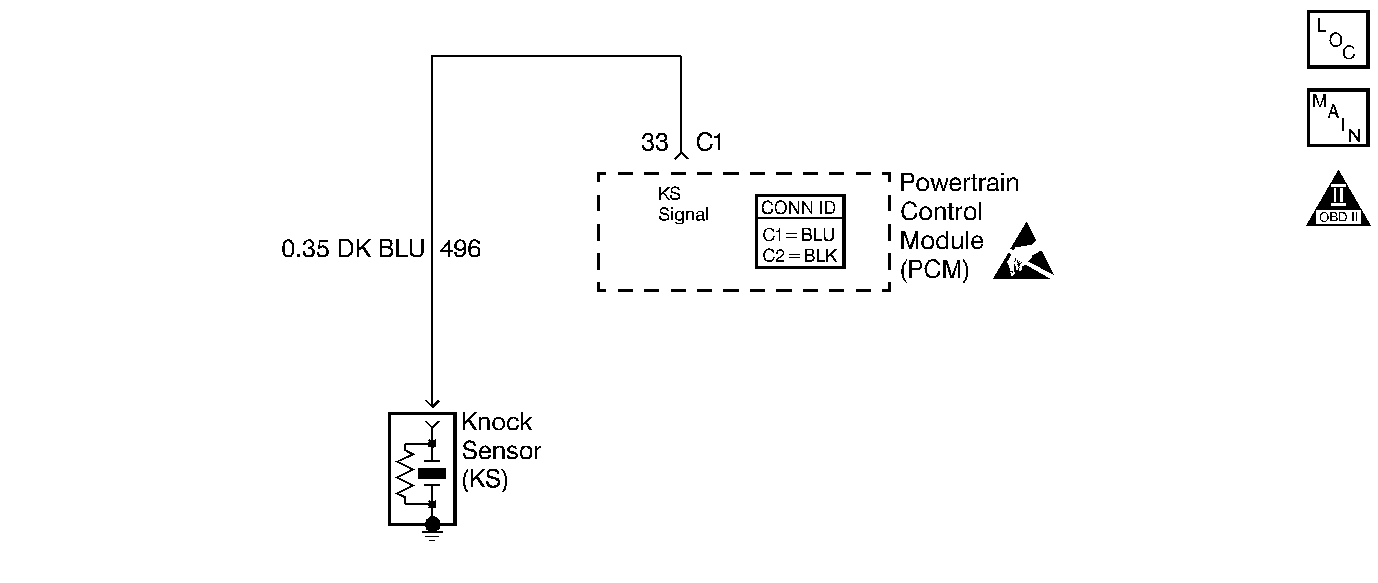
Circuit Description
The knock sensor (KS) system detects an engine detonation. The knock sensor produces an AC voltage signal. The amplitude and the frequency of the AC voltage signal depends on the knock level being detected. This signal then travels to the KS module that is an internal part of the Powertrain Control Module (PCM). If knock is detected, the PCM will retard the spark timing based on the signal from the knock sensor.
Conditions for Running the DTC
| • | The engine run time is more than 20 seconds. |
| • | The engine coolant temperature (ECT) is more than 56°C (131°F). |
| • | The engine speed is more than 1600 RPM. |
| • | The MAP is more than 60 kPa. |
| • | The engine vacuum is less than 33 kPa. |
Conditions for Setting the DTC
| • | The KS voltage and variation is not within normally expected ranges. |
| • | The above condition is present for more than 60 seconds. |
Action Taken When the DTC Sets
| • | The malfunction indicator lamp (MIL) will illuminate after two consecutive ignition cycles in which the diagnostic runs with the fault active. |
| • | The PCM records the operating conditions at the time when the diagnostic fails. This information stores in the Freeze Frame and Failure Records buffers. |
| • | A history DTC stores. |
| • | The coolant fan turns ON. |
Conditions for Clearing the MIL/DTC
| • | The MIL will turn OFF after three consecutive ignition cycles in which the diagnostic runs without a fault. |
| • | A history DTC will clear after 40 consecutive warm-up cycles without a fault. |
| • | Use a scan tool to clear the DTCs. |
Diagnostic Aids
| • | Check and correct any abnormal engine noise before using the diagnostic table. |
| • | Thoroughly inspect any suspected circuitry for the following conditions: |
| - | Backed-out terminals |
| - | Improper mating |
| - | Broken locks |
| - | Improperly-formed connectors |
| - | Damaged terminals |
| - | Faulty terminal-to-wire connections |
| - | Physical damage to the wiring harness |
Test Description
The numbers below refer to the step numbers on the diagnostic table.
-
The Powertrain On-Board Diagnostic (OBD) System Check prompts you to complete some of the basic checks and to store the Freeze Frame and Failure Records data on the scan tool, if applicable. This creates an electronic copy of the data that was captured when the this DTC set. The scan tool stores this data for later reference.
-
If the conditions for the test as described previously are met, a DTC P0325 will set and the MIL will illuminate.
-
If the engine has an internal knock or an audible noise that causes a knocking type of noise on the engine block, this indicates that the knock sensor may be responding to the noise.
-
This step checks the internal resistance of the knock sensor or the wiring to the knock sensor.
-
Thoroughly inspect any suspected circuitry for the following conditions:
-
Reprogram the replacement PCM and perform the crankshaft position system variation learn procedure. Refer to the latest Techline™ information for PCM programming.
| • | Backed-out terminals |
| • | Improper mating |
| • | Broken locks |
| • | Improperly-formed or damaged terminals |
| • | Faulty terminal-to-wire connections |
| • | Physical damage to the wiring harness |
Step | Action | Value(s) | Yes | No | ||||||
|---|---|---|---|---|---|---|---|---|---|---|
Did you perform the Powertrain On-Board Diagnostic (OBD) System Check? | -- | Go to | ||||||||
Does the malfunction indicator lamp (MIL) illuminate? | -- | |||||||||
Listen to the engine while increasing and decreasing the engine speed. Is a knock or an audible noise present? | -- | |||||||||
4 |
Is the action complete? | -- | -- | |||||||
Is the measured value within the specified value? | 90K-110Kohms | |||||||||
Was a repair necessary? | -- | |||||||||
|
Important: Refer to Powertrain Control Module Replacement/Programming . Replace the PCM. Refer to Powertrain Control Module Replacement . Did you complete the replacement? | -- | -- | ||||||||
8 |
Was a repair necessary? | -- | ||||||||
9 |
Was a repair necessary? | -- | ||||||||
10 | Replace the knock sensor (KS). Refer to Knock Sensor Replacement . Is the action complete? | -- | -- | |||||||
11 |
Does the scan tool indicate that this diagnostic ran and passed? | -- | ||||||||
12 | Check to see if any DTCs are set. Does the scan tool display any DTCs that you have not diagnosed? | -- | System OK |
